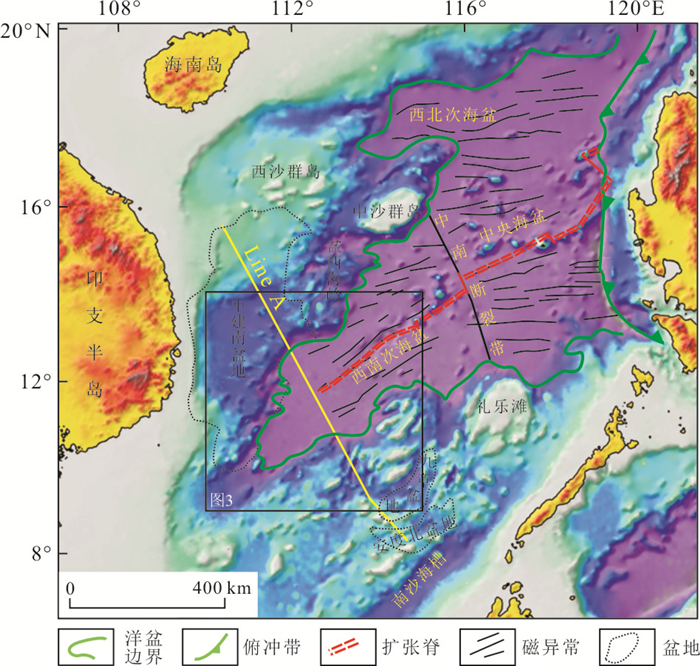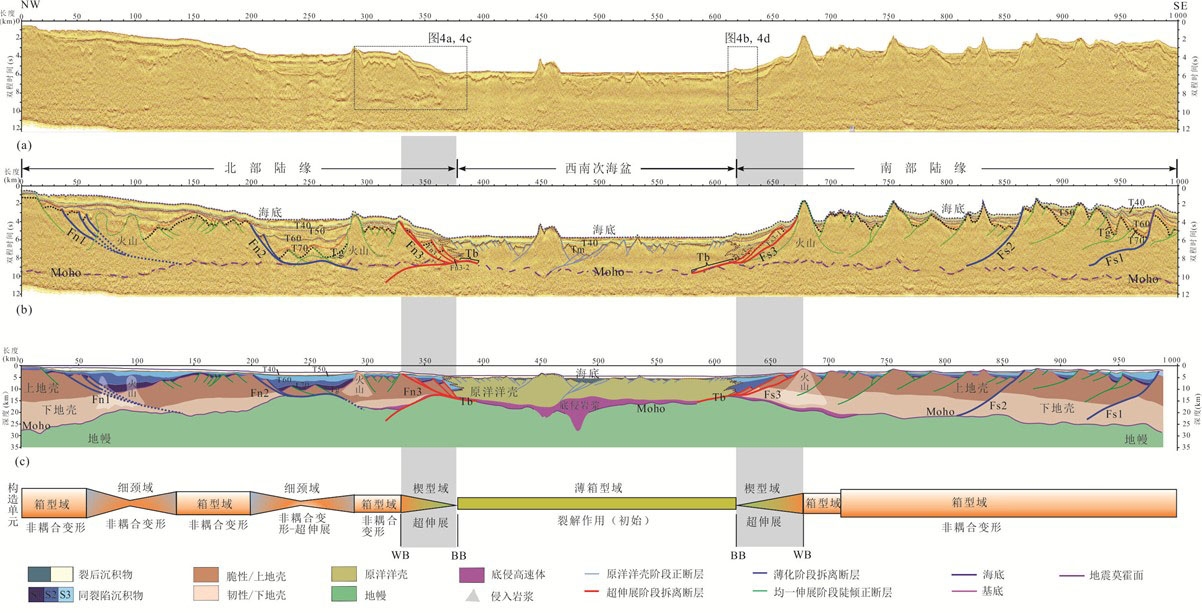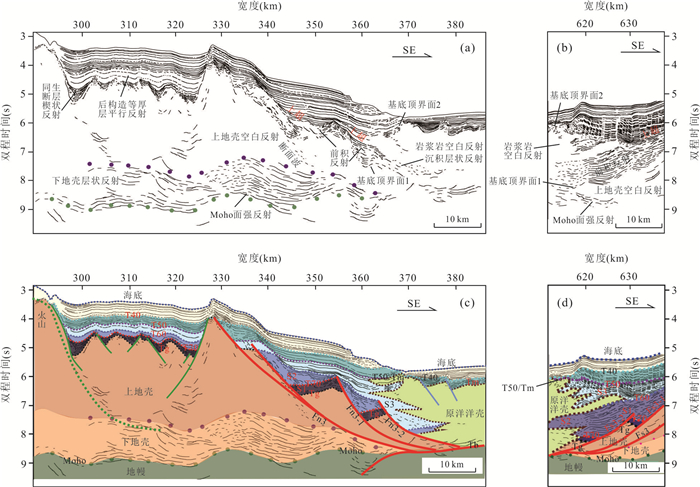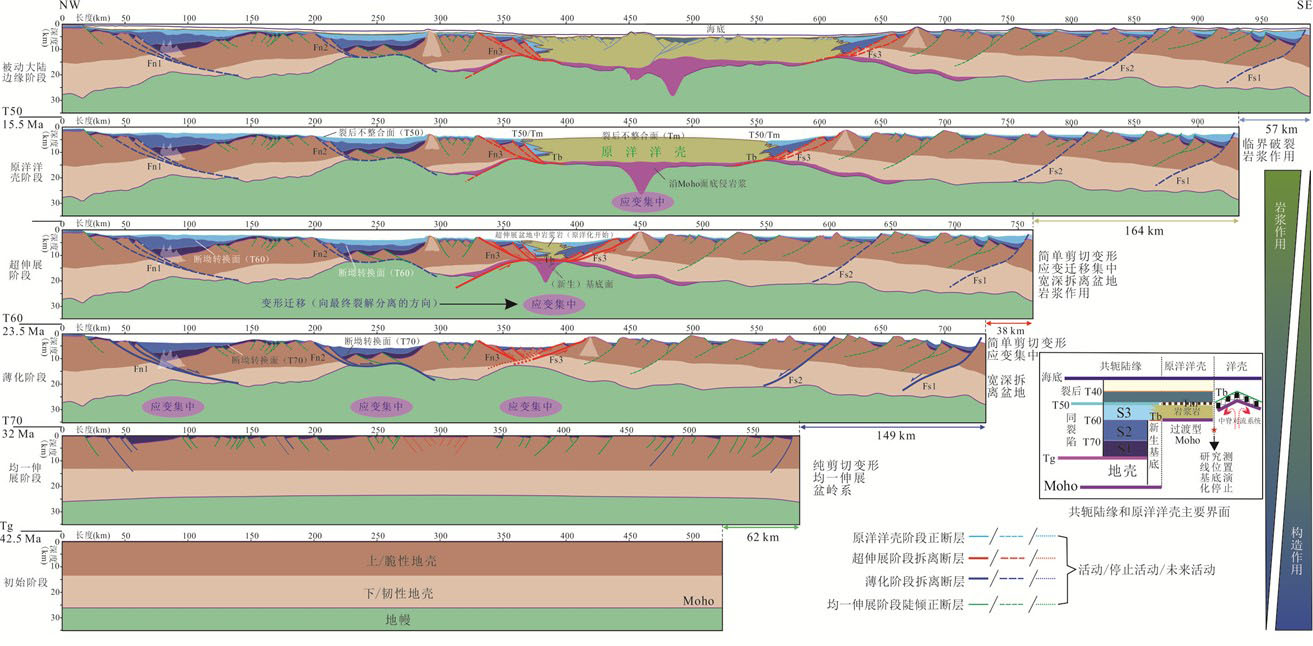|
Arfai, J., Franke, D., Gaedicke, C., et al., 2011. Geological Evolution of the West Luzon Basin (South China Sea, Philippines). Marine Geophysical Research, 32(3): 349-362. https://doi.org/10.1007/s11001-010-9113-x |
|
Briais, A., Patriat, P., Tapponnier, P., 1993. Updated Interpretation of Magnetic Anomalies and Seafloor Spreading Stages in the South China Sea: Implications for the Tertiary Tectonics of Southeast Asia. Journal of Geophysical Research: Solid Earth, 98(B4): 6299-6328. https://doi.org/10.1029/92JB02280 |
|
Bronner, A., Sauter, D., Manatschal, G., et al., 2011. Magmatic Breakup as an Explanation for Magnetic Anomalies at Magma-Poor Rifted Margins. Nature Geoscience, 4(8): 549-553. https://doi.org/10.1038/ngeo1201 |
|
Cameselle, A. L., Ranero, C. R., Barckhausen, U., 2020. Understanding the 3D Formation of a Wide Rift: The Central South China Sea Rift System. Tectonics, 39(12): e2019TC006040. https://doi.org/10.1029/2019TC006040 |
|
Chang, C.P., Angelier, J., Huang, C.Y., 2009. Evolution of Subductions Indicated by Mélanges in Taiwan. In: Lallemand, S., Funiciello, F., eds., Subduction Zone Geodynamics. Springer, Berlin. https://doi.org/10.1007/978-3-540-87974-9_11 |
|
Chao, P., Manatschal, G., Chenin, P., et al., 2021. The Tectono-Stratigraphic and Magmatic Evolution of Conjugate Rifted Margins: Insights from the NW South China Sea. Journal of Geodynamics, 148: 101877. https://doi.org/10.1016/j.jog.2021.101877 |
|
Chen, H., Xie, X. N., Mao, K. N., et al., 2020. Depositional Characteristics and Formation Mechanisms of Deep-Water Canyon Systems along the Northern South China Sea Margin. Journal of Earth Science, 31(4): 808-819. https://doi.org/10.1007/s12583-020-1284-z |
|
Cullen, A., Reemst, P., Henstra, G., et al., 2010. Rifting of the South China Sea: New Perspectives. Petroleum Geoscience, 16(3): 273-282. https://doi.org/10.1144/1354-079309-908 |
|
Funck, T., Hopper, J. R., Larsen, H. C., et al., 2003. Crustal Structure of the Ocean-Continent Transition at Flemish Cap: Seismic Refraction Results. Journal of Geophysical Research: Solid Earth, 108(B11): 2531. https://doi.org/10.1029/2003JB002434 |
|
Gillard, M., Manatschal, G., Autin, J., 2016a. How can Asymmetric Detachment Faults Generate Symmetric Ocean Continent Transitions? Terra Nova, 28(1): 27-34. https://doi.org/10.1111/ter.12183 |
|
Gillard, M., Autin, J., Manatschal, G., 2016b. Fault Systems at Hyper-Extended Rifted Margins and Embryonic Oceanic Crust: Structural Style, Evolution and Relation to Magma. Marine and Petroleum Geology, 76: 51-67. https://doi.org/10.1016/j.marpetgeo.2016.05.013 |
|
Hall, R., 2009. Hydrocarbon Basins in SE Asia: Understanding Why They are There. Petroleum Geoscience, 15(2): 131-146. https://doi.org/10.1144/1354-079309-830 |
|
Keenan, T. E., Encarnación, J., Buchwaldt, R., et al., 2016. Rapid Conversion of an Oceanic Spreading Center to a Subduction Zone Inferred from High-Precision Geochronology. PNAS, 113(47): E7359-E7366. https://doi.org/10.1073/pnas.1609999113 |
|
Larsen, H. C., Mohn, G., Nirrengarten, M., et al., 2018. Rapid Transition from Continental Breakup to Igneous Oceanic Crust in the South China Sea. Nature Geoscience, 11(10): 782-789. https://doi.org/10.1038/s41561-018-0198-1 |
|
Lei, C., Ren, J. Y., 2016. Hyper-Extended Rift Systems in the Xisha Trough, Northwestern South China Sea: Implications for Extreme Crustal Thinning Ahead of a Propagating Ocean. Marine and Petroleum Geology, 77: 846-864. https://doi.org/10.1016/j.marpetgeo.2016.07.022 |
|
Lei, Z. L., Zeng, G., Liu, J. Q., et al., 2021. Melt-Lithosphere Interaction Controlled Compositional Variations in Mafic Dikes from Fujian Province, Southeastern China. Journal of Earth Science, 32(6): 1445-1453. https://doi.org/10.1007/s12583-020-1358-y |
|
Li, C. F., Xu, X., Lin, J., et al., 2014. Ages and Magnetic Structures of the South China Sea Constrained by Deep Tow Magnetic Surveys and IODP Expedition 349. Geochemistry, Geophysics, Geosystems, 15(12): 4958-4983. https://doi.org/10.1002/2014GC005567 |
|
Li, J.B., 2011. Dynamics of the Continental Margins of South China Sea: Scientific Experiments and Research Progresses. Chinese Journal of Geophysics, 54(12): 2993-3003 (in Chinese with English abstract). |
|
Lin, J., Li, J.B., Xu, Y.G., et al., 2019. Ocean Drilling and Major Advances in Marine Geological and Geophysical Research of the South China Sea. Haiyang Xuebao, 41(10): 125-140 (in Chinese with English abstract). |
|
Morley, C. K., 2012. Late Cretaceous-Early Palaeogene Tectonic Development of SE Asia. Earth-Science Reviews, 115(1-2): 37-75. https://doi.org/10.1016/j.earscirev.2012.08.002 |
|
Morley, C. K., 2016. Major Unconformities/Termination of Extension Events and Associated Surfaces in the South China Seas: Review and Implications for Tectonic Development. Journal of Asian Earth Sciences, 120: 62-86. https://doi.org/10.1016/j.jseaes.2016.01.013 |
|
Nirrengarten, M., Mohn, G., Schito, A., et al., 2020. The Thermal Imprint of Continental Breakup during the Formation of the South China Sea. Earth and Planetary Science Letters, 531: 115972. https://doi.org/10.1016/j.epsl.2019.115972 |
|
Pang, X., Zheng, J.Y., Mei, L.F., et al., 2021. Characteristics and Origin of Continental Marginal Fault Depressions under the Background of Preexisting Subduction Continental Margin, Northern South China Sea, China. Petroleum Exploration and Development, 48(5): 1069-1080 (in Chinese with English abstract). |
|
Parsons, T., 1995. The Basin and Range Province. In: Olsen, K., ed., Continental Rifts: Evolution, Structure and Tectonics. Elsevier, Amsterdam. |
|
Penrose, C. P., 1972. Penrose Field Conference on Ophiolites. Geotimes, 17: 24-25. |
|
Peron-Pinvidic, G., Manatschal, G., "IMAGinING RIFTING" Workshop Participants, 2019. Rifted Margins: State of the Art and Future Challenges. Frontiers in Earth Science, 7: 1-8. https://doi.org/10.3389/feart.2019.00218 |
|
Pichot, T., Delescluse, M., Chamot-Rooke, N., et al., 2014. Deep Crustal Structure of the Conjugate Margins of the SW South China Sea from Wide-Angle Refraction Seismic Data. Marine and Petroleum Geology, 58: 627-643. https://doi.org/10.1016/j.marpetgeo.2013.10.008 |
|
Qiu, X. L., Zhao, M. H., Ao, W., et al., 2011. OBS Survey and Crustal Structure of the SW Sub-Basin and Nansha Block, South China Sea. Chinese Journal of Geophysics, 54(6): 1009-1021. https://doi.org/10.1002/cjg2.1680 |
|
Ren, J.Y., Lei, C., 2011. Tectonic Stratigraphic Framework of Yinggehai-Qiongdongnan Basins and Its Implication for Tectonic Province Division in South China Sea. Chinese Journal of Geophysics, 54(12): 3303-3314 (in Chinese with English abstract). |
|
Ren, J.Y., Pang, X., Lei, C., et al., 2015. Ocean and Continent Transition in Passive Continental Margins and Analysis of Lithospheric Extension and Breakup Process: Implication for Research of the Deepwater Basins in the Continental Margins of South China Sea. Earth Science Frontiers, 22(1): 102-114 (in Chinese with English abstract). |
|
Ren, J.Y., Pang, X., Yu, P., et al., 2018. Characteristics and Formation Mechanism of Deepwater and Ultra-Deepwater Basins in the Northern Continental Margin of the South China Sea. Chinese Journal of Geophysics, 61(12): 4901-4920 (in Chinese with English abstract). |
|
Sibuet, J. C., Yeh, Y. C., Lee, C. S., 2016. Geodynamics of the South China Sea. Tectonophysics, 692: 98-119. https://doi.org/10.1016/j.tecto.2016.02.022 |
|
Sun, Z., Lin, J., Qiu, N., et al., 2019. The Role of Magmatism in the Thinning and Breakup of the South China Sea Continental Margin Special Topic: The South China Sea Ocean Drilling. National Science Review, 6(5): 871-876. https://doi.org/10.1093/nsr/nwz116 |
|
Sutra, E., Manatschal, G., Mohn, G., et al., 2013. Quantification and Restoration of Extensional Deformation along the Western Iberia and Newfoundl and Rifted Margins. Geochemistry, Geophysics, Geosystems, 14(8): 2575-2597. https://doi.org/10.1002/ggge.20135 |
|
Taylor, B., Hayes, D. E., 1983. Origin and History of the South China Sea Basin. In: Hayes, D. E., ed., The Tectonic and Geologic Evolution of Southeast Asian Seas and Islands: Part 2. American Geophysical Union Washington, D. C. . https://doi.org/10.1029/gm027p0023 |
|
Vu, A. T., Wessel Fyhn, M. B., Xuan, C. T., et al., 2017. Cenozoic Tectonic and Stratigraphic Development of the Central Vietnamese Continental Margin. Marine and Petroleum Geology, 86: 386-401. https://doi.org/10.1016/j.marpetgeo.2017.06.001 |
|
Wang, P. X., Huang, C. Y., Lin, J., et al., 2019. The South China Sea is not a Mini-Atlantic: Plate-Edge Rifting vs Intra-Plate Rifting. National Science Review, 6(5): 902-913. https://doi.org/10.1093/nsr/nwz135 |
|
Warner, M. R., 1987. Seismic Reflections from the Moho-The Effect of Isostasy. Geophysical Journal International, 88(2): 425-435. https://doi.org/10.1111/j.1365-246x.1987.tb06651.x |
|
Wu, J., Suppe, J., Lu, R. Q., et al., 2016. Philippine Sea and East Asian Plate Tectonics since 52 Ma Constrained by New Subducted Slab Reconstruction Methods. Journal of Geophysical Research: Solid Earth, 121(6): 4670-4741. https://doi.org/10.1002/2016JB012923 |
|
Xie, X. N., Ren, J. Y., Pang, X., et al., 2019. Stratigraphic Architectures and Associated Unconformities of Pearl River Mouth Basin during Rifting and Lithospheric Breakup of the South China Sea. Marine Geophysical Research, 40(2): 129-144. https://doi.org/10.1007/s11001-019-09378-6 |
|
Ye, Q., Mei, L. F., Shi, H. S., et al., 2020. The Influence of Pre-Existing Basement Faults on the Cenozoic Structure and Evolution of the Proximal Domain, Northern South China Sea Rifted Margin. Tectonics, 39(3). https://doi.org/10.1029/2019TC005845 |
|
Zhou, Z. C., Mei, L. F., Liu, J., et al., 2018. Continentward-Dipping Detachment Fault System and Asymmetric Rift Structure of the Baiyun Sag, Northern South China Sea. Tectonophysics, 726: 121-136. https://doi.org/10.1016/j.tecto.2018.02.002 |
|
李家彪, 2011. 南海大陆边缘动力学: 科学实验与研究进展. 地球物理学报, 54(12): 2993-3003. https://www.cnki.com.cn/Article/CJFDTOTAL-DQWX201112004.htm |
|
林间, 李家彪, 徐义刚, 等, 2019. 南海大洋钻探及海洋地质与地球物理前沿研究新突破. 海洋学报, 41(10): 125-140. https://www.cnki.com.cn/Article/CJFDTOTAL-SEAC201910008.htm |
|
庞雄, 郑金云, 梅廉夫, 等, 2021. 先存俯冲陆缘背景下南海北部陆缘断陷特征及成因. 石油勘探与开发, 48(5): 1069-1080. https://www.cnki.com.cn/Article/CJFDTOTAL-SKYK202105021.htm |
|
任建业, 雷超, 2011. 莺歌海-琼东南盆地构造-地层格架及南海动力变形分区. 地球物理学报, 54(12): 3303-3314. https://www.cnki.com.cn/Article/CJFDTOTAL-DQWX201112030.htm |
|
任建业, 庞雄, 雷超, 等, 2015. 被动陆缘洋陆转换带和岩石圈伸展破裂过程分析及其对南海陆缘深水盆地研究的启示. 地学前缘, 22(1): 102-114. https://www.cnki.com.cn/Article/CJFDTOTAL-DXQY201501011.htm |
|
任建业, 庞雄, 于鹏, 等, 2018. 南海北部陆缘深水-超深水盆地成因机制分析. 地球物理学报, 61(12): 4901-4920. https://www.cnki.com.cn/Article/CJFDTOTAL-DQWX201812016.htm |










 下载:
下载:





